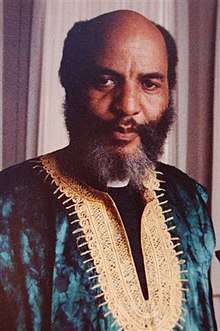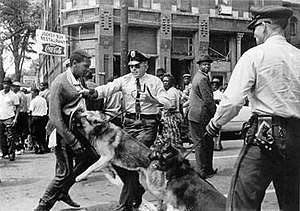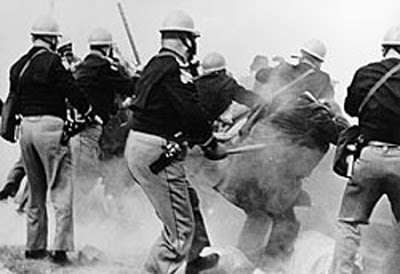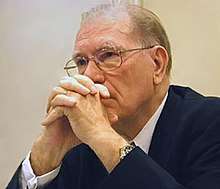James Bevel
James Luther Bevel (October 19, 1936 – December 19, 2008) was a minister and a leader of the Civil Rights Movement in the United States. As the Director of Direct Action and of Nonviolent Education of the Southern Christian Leadership Conference (SCLC), he initiated, strategized, directed, and developed SCLC's three major successes of the era:[2][3] the 1963 Birmingham Children's Crusade, the 1965 Selma voting rights movement, and the 1966 Chicago open housing movement.[4] He suggested that SCLC call for and join a March on Washington in 1963.[5] Bevel strategized the 1965 Selma to Montgomery marches, which contributed to Congressional passage of the 1965 Voting Rights Act.[6]
James Bevel | |
|---|---|
 Bevel in the 1980s | |
| Born | James Luther Bevel October 19, 1936 |
| Died | December 19, 2008 (aged 72) |
| Occupation | Minister and civil rights activist, SCLC Director of Direct Action |
| Known for | Strategist for the Selma voting rights movement, Birmingham Children's Crusade, Selma to Montgomery march, and Chicago Open Housing Movement during the Civil Rights Movement |
| Spouse(s) | Helen Bevel Erica Henry |
| Children | 16[1] |
Prior to his time with SCLC, Bevel worked in the Nashville Student Movement, which conducted the 1960 Nashville Lunch-Counter Sit-Ins, the 1961 Open Theater Movement, and recruited students to continue the 1961 Freedom Rides after they were attacked. He initiated and directed some of the 1961 and 1962 voting rights movement in Mississippi. In 1967, Bevel was chair of the Spring Mobilization Committee to End the War in Vietnam. He initiated the 1967 March on the United Nations as part of the anti-war movement.[7][8] His last major action was as co-initiator of the 1995 Day of Atonement/Million Man March in Washington, DC. For his work Bevel has been called a father of voting rights, the strategist and architect of the 1960s Civil Rights Movement,[9] and half of the first-tier team that formulated many of the strategies and actions to gain federal legislation and social changes during the 1960s civil rights era.[7][8]
In 2005 Bevel was accused of incest by one of his daughters and abuse by three others. He was tried in April 2008. Bevel was convicted of unlawful fornication; pursuant to the recommendation of the jury, which could have sentenced him to anywhere from 5 to 20 years, he was sentenced to 15 years in prison[10] and fined $50,000. After serving seven months he was freed awaiting an appeal; he died of pancreatic cancer in December 2008. He was buried in Eutaw, Alabama.
Early life and education
Bevel was born in 1936 in Itta Bena, Mississippi, the son of Illie and Dennis Bevel.[11] He was one of seventeen children. He grew up in rural LeFlore County of the Mississippi Delta and in Cleveland. He worked on a cotton plantation for a time as a youth and later in a steel mill. He was educated at segregated local schools in Mississippi and in Cleveland, Ohio. After high school he served in the U.S. Navy for a time and seemed headed for a career as a singer.[12]
Called in a different direction, he attended the American Baptist Theological Seminary in Nashville, Tennessee, from 1957 to 1961, becoming a Baptist preacher. He also joined the Southern Christian Leadership Conference.[12] While at seminary, he reread Leo Tolstoy's The Kingdom of God Is Within You, which had earlier inspired his decision to leave the military. Bevel also read several of Mohandas Gandhi's books and newspapers while taking off-campus workshops on Gandhi's philosophy and nonviolent techniques taught by James Lawson of the Southern Christian Leadership Conference. Bevel also attended workshops at the Highlander Folk School taught by its founder, Myles Horton, who emphasized grassroots organizing.[11]
Nashville Student Movement and SNCC
In 1960, along with Lawson's and Horton's students including Bernard Lafayette, John Lewis, Diane Nash and others, Bevel participated in the Nashville Sit-In Movement organized by Nash, whom he would later marry, to desegregate the city's lunch counters and got to know many student leaders. After the success of this action, and with the aid of SCLC's Ella Baker, activist students from Nashville and across the South developed the Student Nonviolent Coordinating Committee (SNCC). Working on SNCC's commitment to desegregate theaters, Bevel successfully directed the 1961 Nashville Open Theater Movement.[13]
At the time the Open Theater Movement had success in Nashville, this was the only city in the country where activists had organized such an action. In this same period, the Congress of Racial Equality (CORE) organized the 1961 Freedom Rides through the Deep South to challenge southern state laws and practices that segregated interstate buses and their facilities despite federal laws for equal treatment. After buses and riders were severely attacked, including a firebombing of a bus and beatings with police complicity in Birmingham, Alabama, CORE suspended the rides.[14] Diane Nash, the Nashville Student Movement's chairman, urged the group to continue the Freedom Rides, and called for college volunteers from Fisk and other universities across the South. Bevel selected the student teams for the buses. He and the others were arrested after they arrived in Jackson, Mississippi and tried to desegregate the waiting-rooms in the bus terminal. Eventually the Freedom Riders reached their goal of New Orleans, Louisiana, generating nationwide coverage of the violence to maintain Jim Crow and white supremacy in the South.[15]
While in the Jackson jail, Bevel and Bernard Lafayette initiated the Mississippi Voting Rights Movement. They, Nash, and others stayed in Mississippi to work on grassroots organizing.[16] Activists encountered severe violence at that time and retreated to regroup. Later efforts in Mississippi developed as Freedom Summer in 1964, when extensive voter education and registration efforts took place. Lafayette and his wife, Colia Lidell, had also opened a SNCC project in Selma, Alabama, to assist the work of local organizers such as Amelia Boynton.
1962 Bevel/King agreement
In 1962, Bevel was invited to meet in Atlanta with Martin Luther King Jr, a minister who was head of the SCLC. At that meeting, which had been suggested by James Lawson, Bevel and King agreed to work together on an equal basis, with neither having veto power over the other, on projects under the auspices of the Southern Christian Leadership Conference (SCLC). They agreed to work until they had ended segregation, obtained voting rights, and ensured that all American children had a quality education. They agreed to continue until they had achieved these goals, and to ask for funding from the SCLC only if the group was involved in organizing a movement.[7][8]
Bevel soon became SCLC's Director of Direct Action and Director of Nonviolent Education to augment King's positions as SCLC's Chairman and spokesperson.
1963 Birmingham Children's Crusade and the March on Washington

In 1963, SCLC agreed to assist its co-founder, Fred Shuttlesworth, and others in their work on desegregating retail businesses and jobs in Birmingham, Alabama, where discussion and negotiations with city officials had yielded little. Weeks of demonstrations and marches resulted in King, Ralph Abernathy, and Shuttlesworth being arrested and jailed. King wanted to fill the jails with protesters, but it was becoming more difficult to find adults to march. They were severely penalized for missing work and were trying to support their families.
Bevel suggested recruiting students in the campaign.[12] King was initially reluctant, but agreed. Bevel spent weeks developing strategy, recruiting and educating students in the philosophy and techniques of nonviolence. Birmingham's 16th Street Baptist Church was a center of the organizing. Bevel directed the students, 50 at a time, to walk to the City Hall to talk to Mayor Art Hanes about segregation in the city. Almost 1,000 students were arrested on the first day. When more arrived to march the following day, Eugene "Bull" Connor, City Commissioner of Public Safety, ordered that German Shepherd dogs and high-pressure fire hoses be used to stop the children from marching. The national and international media were covering the story, and photographs of the force used against schoolchildren generated public outrage against the city and its officials.
During what was called the Birmingham Children's Crusade, President John F. Kennedy asked King to stop using children in the campaign. King told Bevel to refrain from using students. Bevel instead said that he would organize the children to march to Washington D.C. to meet with Kennedy about segregation. King agreed.[5] Bevel went to the children and asked them to prepare to take to the highways for a march on Washington, with the goal of questioning the President about his plans to end segregation in America.[5] hearing of this plan, the Kennedy administration asked SCLC's leaders what they wanted in a comprehensive civil rights bill. Kennedy's staff had drafted one and came to agreement on contents with SCLC's leadership. Bevel agreed to call off the children's march.
In August 1963, SCLC participated in what has become known as the March on Washington, an event organized by labor leader A. Philip Randolph and Bayard Rustin, who had planned the earlier 1941 March.[17]
Alabama Project and the 1965 Selma Voting Rights Movement

In September 1963, a bomb at the 16th Street Baptist Church in Birmingham killed four young girls attending Sunday School and damaged the church. It was later proven that a Ku Klux Klan chapter was responsible. Bevel proposed organizing the Alabama Voting Rights Project, and co-wrote the project proposal with his wife Diane Nash. They moved to Alabama to implement the project along with Birmingham student activist James Orange.
At the turn of the 20th century, southern state legislatures had passed new constitutions and laws that effectively disenfranchised most blacks. Practices such as requiring payment of poll taxes and literacy tests administered in a discriminatory way by white officials maintained the exclusion of blacks from the political system in the 1960s. SNCC had been conducting a Voting Rights Project (headed by Prathia Hall and Worth Long) since the early 1960s, meeting with violence in Alabama. In late 1963 Bevel, Nash, and Orange also worked with local grassroots organizations to educate blacks and support them in trying to gain registration as voters, but made little progress. They invited King and other SCLC leaders to Selma to develop larger protests and actions. work alongside Bevel's and Nash's Alabama Project[4] Together the groups became collectively known as the Selma Voting Rights Movement, with James Bevel as its director.
The Movement began to stage regular marches to the county courthouse, which had limited hours for blacks to register as voters. Some protesters were jailed, but the movement kept the pressure on. On February 16, 1965, Jimmie Lee Jackson, his mother, and grandfather took part in a nighttime march led by C. T. Vivian to protest the related jailing of activist James Orange in Marion, Alabama. The street lights were turned off by Alabama State Troopers who attacked the protesters. In the melee, Jackson was shot in the stomach while defending his mother from an attack. A young man, he died a few days later.
Bevel and others were grieved and outraged. He suggested a march from Selma to Montgomery, the capital, to protest Jackson's death and press Governor George Wallace to support voting rights for African Americans.[8] As the first march reached the end of the Edmund Pettus Bridge and passed out of the city, they were attacked by county police and Alabama State Troopers. The large group were bludgeoned and tear-gassed in what became known as "Bloody Sunday". SNCC Chairman John Lewis and Amelia Boynton were both injured.
In March 1965 protesters made a symbolic march, inspired by a fiery speech by Bevel at Brown Chapel A.M.E. Church, where much organizing was done.[12] They were under an injunction by the state, so stayed within the city limits. Organizers appealed to the federal court against an injunction by the state against marching in order to complete their planned march to the capital. Judge Frank Johnson approved a public march. Following the nationwide publicity generated by Jackson's death and the previous attack on peaceful marchers, hundreds of religious, labor and civic leaders, many celebrities, and activists and citizens of many ethnicities traveled to Selma to join the march. By the time they entered Montgomery 54 miles away, the marchers were thousands strong. Even before the final march occurred, President Lyndon Johnson had gone on national television to address a joint session of Congress, appealing for passage of his administration-backed comprehensive Voting Rights Act.
In 1965 SCLC gave its highest honor, the Rosa Parks Award, to James Bevel and Diane Nash for their work on the Alabama Voting Rights Project.
1966 Chicago open housing movement and the Anti-Vietnam War Movement
In 1966, Bevel chose Chicago as the site of SCLC's long-awaited Northern Campaign.[18] He worked to create tenant unions and build grassroots action to "end" slums. From previous discussions with King, and from work of American Friends Service Committee activist Bill Moyer, Bevel organized, and directed the Chicago open housing movement. Housing in the area was segregated in a de facto way, enforced by covenants and real estate practices. This movement ended within a Summit Conference that included Chicago Mayor Richard J. Daley.
As the Chicago movement neared its conclusion A. J. Muste, David Dellinger, representatives of North Vietnamese leader Ho Chi Minh, and others asked Bevel to take over the directorship of the Spring Mobilization Committee to End the War in Vietnam.[19] Bevel was influential in gaining King's support for the anti-war movement.[12] Bevel agreed to lead the antiwar effort.
He renamed the organization the National Mobilization Committee to End the War in Vietnam, recruited members of many diverse groups, and organized the April 15, 1967 march from Central Park to the United Nations Building in New York City. Originally planned as a rally in Central Park, the United Nations Anti-Vietnam War March became the largest demonstration in American history to that date. During his speech to the crowd that day, Bevel called for a larger march in Washington D.C., a plan that evolved into the October 1967 March on the Pentagon. This rally was attended by tens of thousands of peace activists who followed the growing counterculture movement.[20]
Martin Luther King's assassination
Bevel witnessed King's assassination on April 4, 1968, in Memphis, Tennessee. He reminded SCLC's executive board and staff that evening that King had left "marching orders" that, if anything should happen to him, he intended for Abernathy to take his place as SCLC's Chairman.[21] Bevel opposed SCLC's next action, the 1968 Poor People's Campaign, but served as its Director of Nonviolent Education. Some time after that, he left the SCLC. After King was assassinated Bevel made a claim, described by the New York Times as bizarre, that James Earl Ray was not the killer and that he had evidence that Ray was innocent. Bevel would not reveal the evidence, and Ray was convicted of the crime.[12]
Working with Moon and LaRouche
In the 1980s, Bevel appeared to move to the right and supported Ronald Reagan as president.[12] He lost as the Republican candidate for Illinois' 7th Congressional District in 1984.
In 1989, Bevel and Abernathy organized the National Committee Against Religious Bigotry and Racism. This was financially backed by the Unification Church of Sun Myung Moon, which appeared to be trying to improve its controversial image by allying with such respected leaders.[22][23] A year earlier, Bevel had denounced the deprogramming of a Moon follower and called for the protection of religious rights.[24][25]
Bevel moved to Omaha, Nebraska, in November 1990 as the leader of the "Citizens Fact-Finding Commission to Investigate Human Rights Violations of Children in Nebraska", a group organized by the Schiller Institute.[26] The commission was associated with conspiracy theorist Lyndon LaRouche, and sought to persuade the state legislature to reopen its two-year investigation into the Franklin child prostitution ring allegations. Bevel never submitted the collected petitions and left the state the following summer.[27]
In 1992, Bevel ran on LaRouche's ticket as the vice presidential candidate. At the time, he was living and working in Leesburg, Virginia, near LaRouche's headquarters. LaRouche, characterized as a perennial candidate, was serving a prison sentence for mail fraud and tax evasion.[28] He engaged in LaRouche seminars on issues including "Is the Anti Defamation League the new KKK?"[29] When Bevel introduced LaRouche at a convention of the 1996 National African American Leadership Summit, both men were booed off the stage. A fight broke out between LaRouche supporters and black nationalists.[30]
Criminal charges
In May 2007, Bevel was arrested in Alabama on charges of incest committed sometime between October 1992 and October 1994 in Loudoun County, Virginia. At the time, Bevel was living in Leesburg, Virginia, and working with LaRouche's group, whose international headquarters was a few blocks from Bevel's apartment.
The accuser was one of his daughters, who was 13–15 years old at the time and lived with him. At a family reunion, three other daughters had also alleged that Bevel sexually abused them.[12] Charged with one count of unlawful fornication in Virginia, which has no statute of limitations for incest, Bevel pleaded not guilty and maintained his innocence of incest. During his four-day trial in 2008 the accusing daughter testified that she was repeatedly molested by him, beginning when she was six years old.[31]
During the trial, prosecutors presented key evidence: a 2005 police-sting telephone call recorded by the Leesburg police without Bevel's knowledge. During that 90-minute call, Bevel's daughter asked him why he had sex with her the one time in 1993, and she asked him why he wanted her to use a vaginal douche afterward. Bevel said that he had no interest in getting her pregnant. At trial, Bevel denied committing the sexual act and his recorded statement was used against him.[32]
On April 10, 2008, after a three-hour deliberation, the jury convicted Bevel of incest. His bond was revoked and he was taken into custody.[33] On October 15, 2008, the judge sentenced him to 15 years in prison and fined him $50,000. After the verdict, Bevel claimed that the charges were part of a conspiracy to destroy his reputation, and said that he might appeal. He received an appeal bond on November 4, 2008, and was released from jail three days later, after a diagnosis of pancreatic cancer.[12] Six weeks later he died of cancer, at the age of 72, in Springfield, Virginia.[34]
Bevel's attorney requested that the Court of Appeals of Virginia abate the conviction (which would have cleared Bevel's name) on account of his death. The Court of Appeals remanded the case to the trial court to determine whether there was good cause not to abate the conviction. The trial court found that abating the conviction would deny the victim the closure that she sought and denied the motion to abate. The Court of Appeals affirmed this judgment. Bevel's attorney appealed the denial of the abatement motion to the Supreme Court of Virginia. In an opinion issued November 4, 2011, the state's Supreme Court held that abatement of criminal convictions was not available in Virginia under the circumstances of Bevel's case. Because the executor of Bevel's estate had not sought to prosecute the appeal, the Court affirmed the conviction.[35]
Marriage and family
Bevel was married in 1961 to activist Diane Nash after he completed his seminary studies. They worked together on civil rights, and had a daughter and son together. They divorced after seven years.[36] He married three other women in the following decades, and had told the court during his incest case that he had 16 children born of seven women.[12]
In popular culture
Actor and rapper Common portrays Bevel in the 2014 film Selma.[37]
See also
Notes
- Faithful to my Father's Dream, Enoch Bevel
- Kryn, Randall L. (1989). "James L. Bevel; The Strategist of the 1960s Civil Rights Movement". In Garrow, David (ed.). We Shall Overcome. Brooklyn, New York: Carlson Publishing Company. p. 325. ISBN 978-0926019027.
- Kryn, Randy (October 2005). "Movement Revision Research Summary Regarding James Bevel". middlebury.edu. Middlebury, Vermont: Middlebury College.
- Kryn in Garrow, 1989.
- Kryn in Garrow, 1989, p. 533.
- Fager, Charles (July 1985). Selma, 1965: The March That Changed the South (2nd ed.). Boston, Massachusetts: Beacon Press. ISBN 0-8070-0405-7.
- Kryn in Garrow, 1989, pp. 517, 523–24.
- Kryn, 2005.
- Kryn in Garrow, 1989, title & p. 532.
- Barakat, Matthew (10 April 2008). "Civil Rights Leader Convicted of Incest". Associated Press.
- Halberstam, David (2012). The Children. ISBN 9781453286135.
- Weber, Bruce (December 23, 2008). "James L. Bevel, 72, an Adviser to Dr. King, Is Dead". The New York Times. Retrieved November 25, 2015.
- Zinn, Howard (2002). SNCC: The New Abolitionists. Cambridge, Massachusetts: South End Press.
- Peck, Jim (May 1961). "Freedom Ride" (PDF). CORE-Lator.
- Arsenault, Raymond (2007). Freedom Riders: 1961 and the Struggle for Racial Justice. New York, NY: Oxford University Press.
- Hogan, Wesley (2013-12-01). "In peace and freedom: my journey in Selma". The Sixties. 6 (2): 240–242. doi:10.1080/17541328.2014.898510. ISSN 1754-1328.
- Krogstad, Jen Manuel (August 19, 2013). "Labor unions were key to march's success". USA Today. McLean, Virginia: Gannett. Retrieved January 29, 2020.
- Kryn in Garrow, 1989, pp. 521-22.
- Kryn in Garrow, 1989, pp. 533-34.
- "The Day The Pentagon Was Supposed To Lift Off Into Space" Archived 2005-12-19 at the Wayback Machine, American Heritage magazine, 21 October 2005, Accessed September 15, 2014.
- Kryn in Garrow, 1989, p. 524.
- Leigh, Andrew (October 15, 1989). "Inside Moon's Washington; The Private Side of Public Relations: Improving the Image, Looking for Clout". The Washington Post. Washington, D.C. p. b.01.
- Sargent, Frederic O. (2004). The Civil Rights Revolution: Events and Leaders, 1955-1968. McFarland. p. 137. ISBN 978-0-7864-1914-2.
- "Call Deprogramming 'Spiritual Rape' Church Chiefs Denounce Whelan Acquittal". Omaha World - Herald. Omaha, Nebraska. November 8, 1988. p. 23.
- Hatch, Walter (February 13, 1989). "Big names lend luster to group's causes - Church leader gains legitimacy among U.S. conservatives". The Seattle Times. Seattle, Washington: The Seattle Times Company. p. A1.
- Dorr, Robert (March 10, 1991). "Franklin Stories Called LaRouche 'Moneymaker'". Omaha World-Herald. Omaha, Nebraska: Berkshire Hathaway. p. 1B.
- Dorr, Robert (September 20, 1992). "Activist in Franklin Probe Is LaRouche Running Mate". Omaha World - Herald. Omaha, Nebraska: Berkshire Hathaway. p. 7B.
- Barakat, Matthew (April 10, 2008). "Civil rights leader convicted of incest". USA Today. Retrieved May 5, 2010.
- LaRouche Connection Master List 1991-1995
- Manning, Marable (Spring 1998). "Black fundamentalism". Dissent. New York. pp. 69–77.
- "Allegations Pour In Against Civil Rights Leader Accused Of Incest". Washington, DC: NBC-WRC. Archived from the original on 2007-09-29. Retrieved 2007-06-15.
- Brubaker, Bill (April 11, 2008). "Civil Rights Leader Convicted of Incest". The Washington Post.
- Brubaker, Bill (April 12, 2008). "Incest Verdict Is Bittersweet For Daughter Of Minister". The Washington Post. Archived from the original on September 18, 2012.
- Remington, Alexander (December 24, 2008). "The Rev. James L. Bevel dies at 72; civil rights activist and top lieutenant to King". The Los Angeles Times.
- "Bevel v. Commonwealth (4 Nov. 2011)". U.S. Law. Justia. Retrieved 7 June 2020.
- Hall, Heidi (April 21, 2013). "Years After Change, Activist Lives Her Conviction". USA Today. Retrieved August 2, 2013.
- Fleming, Mike Jr. (9 May 2014). "Common Is James Bevel, Andre Holland Is Andrew Young In Ava DuVernay's Mlk Tale 'Selma'". Deadline. Retrieved 5 June 2014.
External links
| Wikimedia Commons has media related to James Bevel. |
- James Bevel profile, The Martin Luther King Jr. Research and Education Institute
- Statements by Rev. James L. Bevel, The Freedom Rides (see request for download at bottom of page). From the Helen L. Bevel Archives.
- SNCC Digital Gateway: James Bevel, Documentary website created by the SNCC Legacy Project and Duke University, telling the story of the Student Nonviolent Coordinating Committee and grassroots organizing from the inside-out
- Appearances on C-SPAN
- Washington Post "A Father's Shadow" Les Carpenter; May 25, 2008
